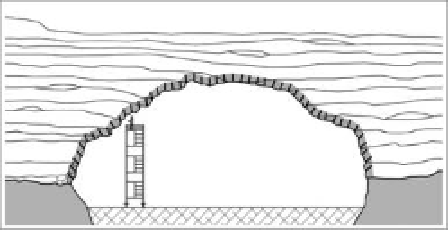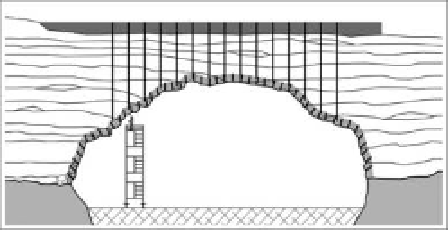Environmental Engineering Reference
In-Depth Information
4.3
Short bolts
it was intended to create a consolidated arch of
approximately one meter thick. in order to achieve
this arch, meter long and 22 mm diameter bore-
holes were drilled. Fiberglass and polyester bolts,
with high resistance to traction and inert to saline
aggression, were introduced in the boreholes. The
structural characteristics of the bolts are: deforma-
tion module 47 GPa, resistance to traction 1040 MPa
and maximum elongation 2.3%. The approximate
grid was 1 × 1 meter. once each bolt was intro-
duced the borehole was sealed and a medium vis-
cosity epoxy resin (30,000 cP) was injected to form
a consolidated stone block.
since it was impossible to find in the market
suitable drilling machinery for these works, very
light and powerful pneumatic drilling machinery
were designed. a total of 2000 short bolts were
specially manufactured for this job.
Figure 5.
consolidation of the 4 meters thick arch.
4.4
Long bolts
once this monolithic rock layer was achieved it was
necessary to tie this first meter to the higher strata,
and somehow “hang” that first consolidated meter
from higher strata. To do so, 46 mm diameter bore-
holes were drilled, at least 4 m long. The grid was
2 × 2 m. it was planned to place in each of these
holes a long bolt, fiberglass and polyester made,
four meters long and 25 mm diameter, that later,
as in the case of short bolts should be injected with
medium viscosity epoxy resin. Before this step an
inspection of the boreholes was carried out with a
TV camera, founding out that there were numer-
ous large hollows. This forced to unplanned sup-
plementary treatment, described below.
once the boreholes were drilled they were
injected with expansive polyurethane resins, able
to increase up to 20 times its original volume with-
out applying pressure when swelling. By doing so,
the hollows were filled allowing drilling the bore-
holes again, placing the fiberglass bolts and their
subsequent injection with epoxy resins. More than
5000 liters of these resins were consumed.
Figure 6.
lightweight concrete slab.
4.5
Lightweight concrete slab
in specific areas, higher strata, above the first meter
consolidated arch, were considered insufficient to
carry the long bolting. For this reason, an artificial
stratum was created to anchor the long bolts, using
a lightweight reinforced concrete slab.
once lightened concrete had hardened, a grid
of boreholes of 46 mm diameter was drilled from
the concrete slab. The TV camera was introduced
in every borehole, discovering numerous large
hollows that decreased dangerously the remain-
der structural resistance to the entire area. it was
decided to fill these gaps by injecting a grout of
low-density, high strength, excellent adhesion to
the rock and null retraction.
after that the boreholes were redrilled introduc-
ing a 25 mm fiberglass and polyester bolt in each
of them, diameter, which was injected with resin
epoxy resin.
4.6
Micro bolts
in specific areas, with the aim of holding loose
rocks, small reinforcements of micro bolts of
8 mm diameter and variable length up to 50 cm
long, and capable of supporting up to 160 kg
were made with from fiberglass resin polyester.
The annular space between rock and bolts was
also injected with resin epoxy. a total amount of
1200 items were made.
Figure 4.
consolidation of the one meter thick arch.


















